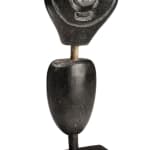-
Artworks
KAROO ASHEVAK (1940-1974) TALOYOAK (SPENCE BAY)
Figure, 1971stone, wood, and antler, 7.5 x 3 x 2.75 in (19.1 x 7.6 x 7 cm), measurements reflect dimensions with base.
apparently unsigned.LOT 100
ESTIMATE: $30,000 — $50,000
PRICE REALIZED: $33,600.00Further images
Karoo Ashevak began carving soon after his move into Spence Bay in 1968. He was one of numerous Spence Bay Inuit who tried their hand at carving the whale bone...Karoo Ashevak began carving soon after his move into Spence Bay in 1968. He was one of numerous Spence Bay Inuit who tried their hand at carving the whale bone that had been specially flown into the community. His career took off in 1970, and by 1973 he had three solo exhibitions to his credit, including one in New York City. Tragically he and his wife died in a house fire in 1974. However it is safe to say that the works he produced in five short years changed Inuit art forever.
Ashevak’s true gift was his fearless experimental approach, his ability to mix materials and piece them together in new and surprising ways (see Lot 81). Not only did he freely combine bone, antler, ivory, stone and other materials, he also pegged and otherwise constructed his figures in daring new ways. About halfway into his career he began mismatching facial features and other body parts as well. Constant experimentation with materials and methods and styles perfectly suited Karoo’s favourite themes of shamanism and the spirit world.
Ashevak’s primary carving material was whale bone, but Jean Blodgett’s seminal monograph on the artist does illustrate three works in which stone is the primary component or an important one [1]. Of the four works cited below, three are quite early, dated 1971, while the third is dated 1974. This Figure probably dates from 1971 as well, or possibly even late 1970, as it is likely the earliest example of them all.
Although early and relatively simplified in form, Figure already exhibits Karoo’s signature revolutionary style: the pegging together of separate body parts; the expressionistic, distorted facial features (quite similar to those seen in early whale bone works; see Blodgett, Karoo Ashevak, 1977, cats. 11 and 12); and enigmatic subject matter (Figure, if human, could be a shaman, but it might just as easily depict a spirit). To boot, Figure is delightfully charming.
1. Blodgett, Karoo Ashevak, 1977, cats. 8, 10, and 42. Another stone example, formerly in the Albrecht Collection, illustrated in Walker’s Auctions, Ottawa, 18 November 2015, Lot 137.
References: See Jean Blodgett's landmark retrospective show and catalogue Karoo Ashevak, (Winnipeg: Winnipeg Art Gallery, 1977). See also American Indian Arts Center, Karoo Ashevak: Spirits, (New York: American Indian Arts Center, 1973); Gerald McMaster, ed., Inuit Modern: The Samuel and Esther Sarick Collection, (Toronto: Art Gallery of Ontario, 2010), pp. 118-119; Ingo Hessel, Inuit Art: An Introduction, (Vancouver: Douglas & McIntyre / New York: Harry Abrams / London: British Museum Press, 1998), figs. 89-90, pp. 111-112; First Arts Auction, 12 July 2020, Lot 40.
Provenance
Waddington’s Auctions, Toronto, Nov. 1990, Lot 319;Acquired from the above by the present Private Collection, Toronto.
Join our mailing list
* denotes required fields
We will process the personal data you have supplied in accordance with our privacy policy (available on request). You can unsubscribe or change your preferences at any time by clicking the link in our emails.












